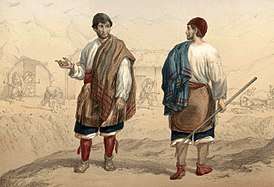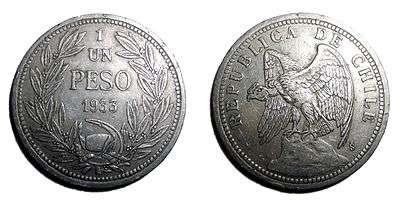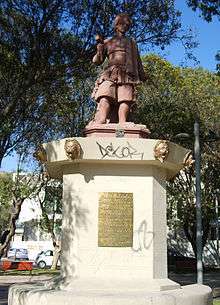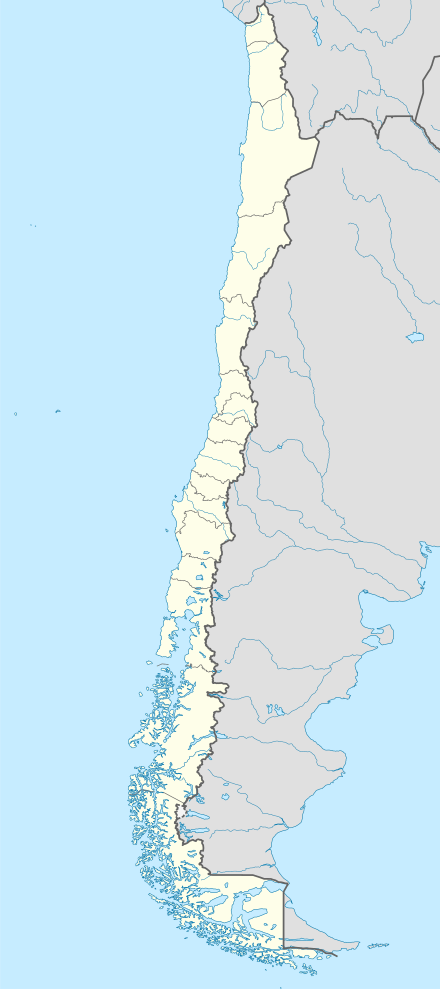Chilean silver rush
Between 1830 and 1850 Chilean silver mining grew at an unprecedented pace which transformed mining into one of the country's principal sources of wealth. The rush caused rapid demographic, infrastructural, and economic expansion in the semi-arid Norte Chico mountains where the silver deposits lay. A number of Chileans made large fortunes in the rush and made investments in other areas of the economy of Chile. By the 1850s the rush was in decline and lucrative silver mining definitely ended in the 1870s. At the same time mining activity in Chile reoriented to saltpetre operations.
 Drawing of early 19th-century Chilean silver miners | |
| Date | 1830-1850 |
|---|---|
| Location | Norte Chico Mountains, Chile |
| Cause | Major silver strikes in Copiapó, Chañarcillo in 1832 and Tres Puntas in 1848 |
| Participants | Chilean miners |
| Outcome | Influx of silver miners led to the rapid demographic, infrastructural, and economic expansion of mining and non-mining industries in the Norte Chico mountain region of Chile |
| History of Chile |
|---|
.svg.png) |
|
Early history |
|
Nation-building
|
|
Republican period |
|
Parliamentary period
|
|
Presidential period
|
|
Pinochet regime
|
|
Contemporary
|
|
Related topics
|
Background
Placer deposits of gold were exploited by the Spanish in the 16th century following their arrival in the same century.[1] However, only after the independence in the 19th century did mining once again get prominence among economic activities in Chile.[1] Following the discovery of silver at Agua Amarga (1811) and Arqueros (1825) the Norte Chico mountains north of La Serena were exhaustively prospected.[2][3][4]
Growth cycle
| Economic history of Chile |
|---|
 |
|
Colonial era
|
|
Early republic |
|
Internal growth
|
|
Return of liberalism |

In May 16,[5] 1832 prospector Juan Godoy found a silver outcrop (reventón) 50 km south of Copiapó in Chañarcillo.[2] According to folklore Godoy was guided to the riches of Chañarcillo by an alicanto.[5] Godoy successfully claimed the discovered outcrop in his name and the name of José Godoy and Miguel Gallo.[2] The finding attracted thousands of people to the place and generated significant wealth.[3] During the heyday of Chañarcillo it produced more than 332 tons of silver ore until the deposits begun to be exhausted in 1874.[6] A settlement of 600 people mushroomed in Chañarcillo leading to the establishment of surveillance system to avoid disorders and theft of ore.[6] The settlement evolved over time to a town named Juan Godoy which came to have a plaza, school, market, hospital, theater, a railroad station, a church and graveyard.[6]
Following the discovery of Chañarcillo many other ores were found near Copiapó well into the 1840s.[2] The many findings resulted in the court of Copiapó receiving numerous claims (denuncios).[6] In 1848 another large ore deposit was discovered at Tres Puntas sparkling yet another rush.[4]
Copiapó experienced a large demographic and urbanistic growth during the rush.[2] The town became a centre for trade and services of a large mining district.[3] In 1851 Copiapó was connected by railroad to Caldera, its principal port of export.[3] The mining zone slowly grew northwards into the diffuse border with Bolivia.[4] Agriculture in Norte Chico also expanded as a consequence of the rush.[7]
Aftermath
By 1855, Copiapó was already in decline.[2] At the end of the silver rush, rich miners had diversified their assets into banking, agriculture, trade and commerce all over Chile.[2] Example of this is silver mining magnate Matías Cousiño who initiated coal mining operations in Lota in 1852 rapidly transforming the town, from being a sparsely populated frontier zone in the mid-19th century, into a large industrial hub.[8][9][10]
In 1870, 1570 miners worked in the Chañarcillo mines; however the mines were exhausted by 1874 and mining ended in 1888 after the mines became flooded.[6][11] Despite this, Chañarcillo was the most productive mining district in 19th century Chile.[4]
A last major discovery of silver occurred 1870 in Caracoles in Bolivian territory adjacent to Chile.[4] Apart from being discovered by Chileans, the ore was also extracted with Chilean capital and miners.[3][4]
See also
- Chilean wheat cycle
- Guano Era
- Mapuche silverwork
- Tierra del Fuego Gold Rush
- War of the Pacific
References
- "Historia de la Minería Chilena". Icarito (in Spanish). University of Chile. 18 April 2011. Archived from the original on 13 June 2013.
- Villalobos R., Sergio; Silva G., Osvaldo; Silva V., Fernando; Patricio, Estelle M., eds. (1995) [1974]. Historia de Chile [History of Chile] (in Spanish). Santiago de Chile: Editorial Universitaria. pp. 469–472.
- "Los Ciclos Mineros del Cobre y la Plata (1820-1880)" [Mining Cycles of Copper and Silver]. Memoria Chilena (in Spanish). Biblioteca Nacional de Chile. Archived from the original on 31 December 2013.
- Bethell, Leslie, ed. (1993). Chile Since Independence. Cambridge: Cambridge University Press. pp. 13–14. ISBN 978-0-521-43375-4. LCCN 92017160. OCLC 25873947.
- Montecino Aguirre, Sonia (2015). "Alicanto". Mitos de Chile: Enciclopedia de seres, apariciones y encantos (in Spanish). Catalonia. p. 47–48. ISBN 978-956-324-375-8.
- Baros M., María Celia (November 2008). "Juan Godoy y Chañarcillo". Minería Chilena. No. 329. Archived from the original on 23 May 2013.
- Bengoa, José (2000) [1985]. Historia del pueblo mapuche: Siglo XIX y XX [Mapuche History: Nineteenth and Twentieth Centuries]. Biblioteca del bicentenario (in Spanish) (6th ed.). Santiago de Chile: LOM Ediciones. p. 155. ISBN 978-956-282-232-9.
- Mazzei, Leonardo (2000). "Expansión de gestiones empresariales desde la minería del norte a la del carbón, Chile, siglo XIX" (PDF). Historias (in Spanish). 46: 91–102.
- Davis, Eliodoro Martín (1990). "Breves recuerdos de algunas actividades mineras del carbón". Actas. Segundo Simposio sobre el Terciario de Chile (in Spanish). Santiago, Chile: Departamento de Geociencias, Facultad de Ciencias, Universidad de Concepción. pp. 189–203.
- Vivallos Espinoza, Carlos; Brito Peña, Alejandra (2010). "Inmigración y sectores populares en las minas de carbón de Lota y Coronel (Chile 1850-1900)" [Immigration and popular sectors in the coal mines of Lota and Coronel (Chile 1850-1900)]. Atenea (in Spanish). 501: 73–94.
- Valenzuela Jara, A.E. "History of mining in Chile (part 2)". www.cim.org.
